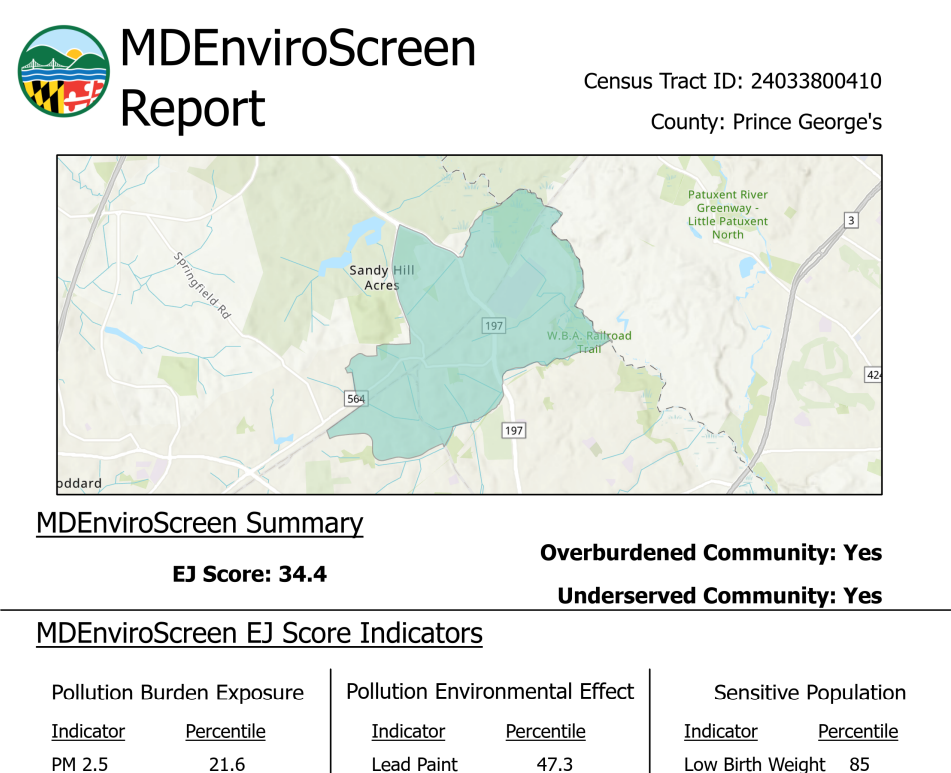This tool provides users with data to inform their decisions on siting, permitting, enforcement, and infrastructure improvements. Demographic and socioeconomic data, coupled with state agency data such as proximity to active high air emission facilities or wastewater treatment facilities, will be used to help underserved and overburdened communities in Maryland.
Disclaimer
The MDEnviroScreen EJ score represents a combined measure of pollution and the potential vulnerability of a population to the effects of pollution. The EJ score in MDEnviroScreen does not include data from every available map layer. For example, it does not include race/ethnicity, language proficiency, or age, however, MDE has made that information available for informational purposes only. Collecting and displaying this data allows users to evaluate the relationships between demographics and pollution burden, and can be used to better understand issues related to environmental justice and racial equity in Maryland. MDE cautions users against using the "Underserved" map layer, or its subcategories, in any manner that would be considered discriminatory under applicable law.
EJ Score Calculation
The term “EJ Score” means an overall evaluation of an area’s environment and environmental justice indicators, as defined by MDE in regulation, and aggregates data in the following sub-indices: (1) pollution burden exposure; (2) pollution burden environmental effects; and (3) sensitive populations, including socioeconomic factors. Find a printer-friendly version of our detailed methodology
here.
We strongly encourage permit applicants to look beyond the summary EJ Score into the specific indicators above the 75th percentile in a given community to identify their unique concerns, and to note that MDEnviroScreen will not fully capture every concern.
Overburdened Communities
State law defines Overburdened Communities as any census tract where three or more environmental or health indicators are higher than 75 percent of other tracts statewide. These indicators include levels of fine particulate matter in the air, ozone, proximity to industrial facilities or hazardous waste sites, traffic levels, rates of asthma-related emergency room visits, and other health and environmental conditions.
Underserved Communities
State law defines Underserved Communities as any census tract in which:
- At least 25% of the residents qualify as low-income
- At least 50% of the residents identify as nonwhite
- At least 15% of the residents have limited English proficiency
Permit Application Requirements
State law (HB 1200) requires applicants seeking a permit under §1-601 of the Environment Article of the Annotated Code of Maryland, or any permit requiring public notice and participation, to include the EJ Score for the census tract where the applicant is seeking the permit in their application.
Applicants must include the MDEnviroScreen Report with the EJ Score as part of the permit application upon submission. An application will not be considered complete without the report. Applicants should also include a discussion of the community's environmental exposures. This will help determine the best way to engage with the community.
Communities with high indicator scores, particularly those with five or more indicators at or above the 75th percentile, should have more opportunities to participate in the permit process and understand a project's potential impacts. Certain permits may require applicants to take action if a census tract has an overall EJ Score greater than the 75th percentile. Applicants should follow these existing permit instructions where applicable.
Instructions for Permit Applicants
To generate an EJ Score,
launch the MDEnviroScreen using the link at the top of this page. Input the address or coordinates (as “longitude, latitude”) of the proposed installation in the search bar at the top right of your screen. The tool will zoom in and pin the location at the center of the screen. Click on the illuminated dot, and a dialogue box will automatically generate (see below).

Click “Download the Report” below the MDEnviroScreen Summary table to generate a printer-friendly MDEnviroScreen Report (see below).

To learn more about this easy-to-use tool join one of our upcoming webinars. MDEnviroScreen helps you explore local environmental conditions with clear, visual data. Gain valuable insights, see the bigger picture, and use this knowledge to spark change and inspire innovation in your community. Don’t miss your chance to learn how to make the data work for you!
Future webinar dates;
October 29th at 10:00 am
November 20th at 10:00 am
December 1st at 10:00 am
December 15th at 10:00 am
This is the link to the Maryland GIS Data Catalog. To access the EJ or CVS data enter either in the search option or by hovering over Environment and clicking on Data. Then on that landing page, enter EJ or CVS in the search bar to get to either site.
https://data.imap.maryland.gov
Watch a 30-minute webinar recording on MDEnviroScreen, a powerful EJ mapping tool designed to identify and address environmental justice concerns. This tool utilizes 21 indicators to track community pollution levels and offers features to pinpoint areas experiencing environmental justice issues. Learn how MDEnviroScreen supports equitable decision-making, fosters transparency by including EJ Scores on environmental permit applications, and aids climate resilience efforts by integrating vulnerability data. Discover its value for policymakers, community members, and regulatory agencies in promoting environmental equity. View the recording here:
https://www.youtube.com/watch?v=xRogL2cVmT0
This page was last updated October 2025.